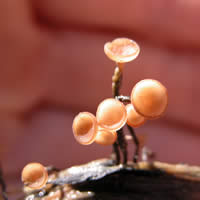USDA Forest Service Celebrating Wildflowers
|
|
|
 |
|
What are lichens?Have you ever seen a lichen and knew that it was a lichen? Not many people know what lichens are, and who would? They seem as though they are from another planet! Lichens are bizarre organisms and no two are alike. Lichens are a complex life form that is a symbiotic partnership of two separate organisms, a fungus and an alga. The dominant partner is the fungus, which gives the lichen the majority of its characteristics, from its thallus shape to its fruiting bodies. The alga can be either a green alga or a blue-green alga, otherwise known as cyanobacteria. Many lichens will have both types of algae. What are fungi?
Fungi are a diverse group of organisms that are in their own kingdom (Fungi), separate from plants. Fungi do not contain chlorophyll or any other means of producing their own food so they rely on other organisms for nutrition. Fungi are widely known for their role in the decomposition of organic matter. They are also necessary for the survival of the ecosystem around them, such as partnering with plants and trees for nutrients and survival. Lichens are another such partnership for fungi to gain nutrients from another organism. The algal partner photosynthesizes and provides food for the fungus, so it can grow and spread. What are algae?
Algae are in another kingdom (Protista) separate from plants and fungi. There are several types of algae: green, brown, red, gold. They can survive in salt water and in freshwater on their own, and in any environment when part of a lichen relationship. Although cyanobacteria are called blue-green algae, they are actually bacteria, and are part of the bacteria kingdom, Monera. The "blue" in the common name refers to the fact that they need to live in water, and "green algae" refers to their photosynthetic abilities, like green algae. |
|
| NOTE: PDF format links require the Adobe Acrobat Reader to view. | |
| top | Disclaimers | FOIA | Privacy Policy | Quality of Information | Photo Credits & Use |
Location: http://www.fs.fed.us/wildflowers/interesting/lichens/whatare.shtml
Last modified: Tuesday, 24-Jun-2008 21:54:38 EDT

